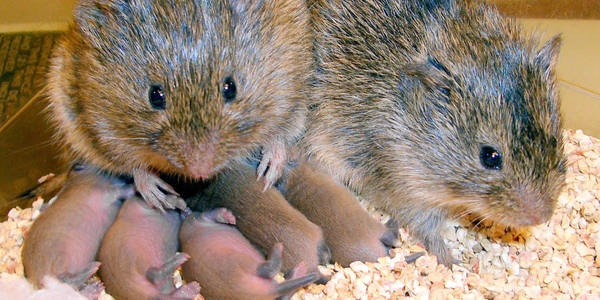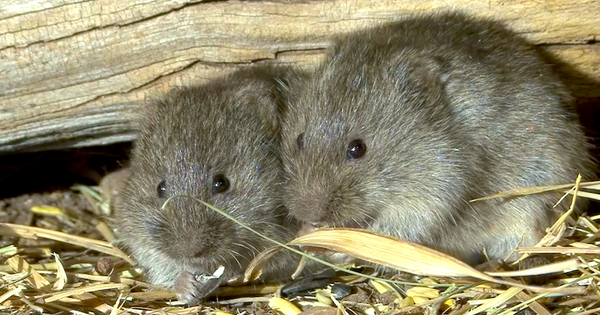It is true that prairie voles without oxytocin receptors can still bond with their mates and young. However, the nature of this bond may differ from that of prairie voles with intact oxytocin receptors.
The importance of oxytocin, the “love hormone,” in social attachments is being questioned. Despite more than four decades of pharmacological and behavioral research pointing to oxytocin receptor signaling as an essential pathway for the development of social behaviors in prairie voles, humans, and other species, a genetic study published in the journal Neuron shows that voles can form enduring attachments with mates and provide parental care without oxytocin receptor signaling.
Prairie voles are one of only a few mammalian species that are monogamous. They form lifelong partnerships known as “pair-bonds” after mating. Pair-bonded voles share parental responsibilities, prefer their partner’s company to that of unknown members of the opposite sex, and actively reject potential new partners. Previous research using drugs to prevent oxytocin from binding to its receptor discovered that when oxytocin signaling was inhibited, voles were unable to pair-bond.
Devanand Manoli of UCSF and Nirao Shah of Stanford University wanted to know if oxytocin receptor signaling was truly controlling pair-bonding. They used CRISPR to create prairie voles lacking functional oxytocin receptors to test this. The mutant oxytocin-receptor-less voles were then tested to see if they could form long-term partnerships with other voles. The mutant voles formed pair-bonds just as easily as normal voles, which surprised them.
People have been hoping for at least the last ten years for the possibility of oxytocin as a powerful therapeutic for helping people with social cognitive impairments caused by conditions ranging from autism to schizophrenia. This study demonstrates that there is unlikely to be a silver bullet for something as complex and nuanced as social behavior.
Nirao Shah
“We were all shocked that no matter how many different ways we tried to test this, the voles demonstrated a very robust social attachment with their sexual partner, as strong as their normal counterparts,” says Manoli.
Next, the researchers wondered whether oxytocin receptor signaling is similarly dispensable for its other functions — parturition, parenting (which, in prairie voles, is a shared responsibility between the two parents), and milk release during lactation.
“We discovered that mutant voles can not only give birth, but also nurse,” Shah explains. Both male and female mutants engaged in typical parental behaviors such as huddling, licking, and grooming, and were able to rear pups to weaning age.
However, the mutant prairie voles produced less milk than normal voles. As a result, fewer of their pups survived to weaning age, and those that did survived were smaller than normal prairie vole pups. The fact that the voles could nurse at all contrasts with similar studies in oxytocin receptor-deficient mice, which failed to lactate or nurse and whose pups died within a day or two of birth.

The authors hypothesize that this species difference could be due to the inbred nature of laboratory mouse strains in contrast to the genetically heterogenous voles. “It could be that inbreeding in mice has selected for a large dependence on oxytocin signaling, or this may represent a species-specific role of oxytocin receptor signaling,” says Shah.
When asked why their findings differ from those of previous studies that used drugs to block oxytocin receptor signaling, the authors point to a key distinction between genetic and pharmacological studies: precision. “Drugs can be dirty in the sense that they can bind to multiple receptors and you don’t know which binding action is causing the effect,” Manoli says. From a genetic standpoint, we now know that the precision of deleting this one receptor and then eliminating its signaling pathways has no effect on these behaviors.”
“People have been hoping for at least the last ten years for the possibility of oxytocin as a powerful therapeutic for helping people with social cognitive impairments caused by conditions ranging from autism to schizophrenia,” Manoli says. “This study demonstrates that there is unlikely to be a silver bullet for something as complex and nuanced as social behavior.”
Another significant difference is that, whereas most pharmacological studies suppress oxytocin receptor signaling in adult animals, this study turned it off in embryonic voles. “We’ve created a mutation that begins before birth,” Shah explains. “It’s possible that compensatory or redundant pathways kick in and mask the deficits in attachment, parental behaviors, and milk let-down in these mutant animals.”
Working with prairie voles was a challenge, but one worth overcoming. Because prairie voles, unlike laboratory mice, are not commonly used in genetic studies, the team had to create all of their molecular tools and protocols from scratch. The authors are excited about the possibilities now that they have these vole-specific pipelines and tools, both for themselves and for other researchers.
“We’re very happy to be a part of a community and to have this technology that we can share,” Manoli says. “Now that we have this treasure, we can begin to mine it. There are numerous other questions that prairie voles could be useful in answering, both in terms of potential clinical implications for models of anxiety or attachment and in terms of basic comparative biology.”





